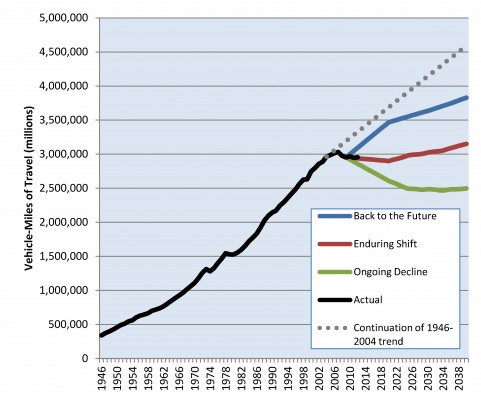What happens when driving rates continue to drop?
Anyone who follows this blog, or transportation discussions in general, is well aware that the miles driven per American has been dropping in recent years and that the millennial generation (16-34) is leading the charge. Indeed, the typical American drives less today than at the end of Bill Clinton’s first term.
But how likely is that trend to hold in the future? And if it does, what does that say about what we should be building, and how we will pay for it, if not with the gas taxes raised from driving? A report out today from the U.S. PIRG Education Fund and Frontier Group seeks to answer the first question, and to fuel a conversation about the second.

None of the likely scenarios sees miles of driving returning to the heights of previous trends.
The short answer to Question 1: No plausible scenario sees per capita driving rates continuing their formerly inexorable climb, and all fall well below current government projections. And no, the authors do not assume that we are entering permanent economic recession, because the underlying are likely to trends persist whatever the strength of the economy:
Millennials. Americans under 35 drive nearly one-fourth less now than those who where the same age a decade ago. There are myriad likely reasons: The cost of car ownership, their tendency to live in more urban locales, reduced employment rates during the recession, etc. But the authors site many reasons why their driving rates may remain lower than previous generations, even during child-bearing years.
Baby boomers. The post-war generation drove workforce participation rates to unheard of levels, and now those workers are nearing the end of their commuting years. And while self-driving cars might allow granny to keep motoring, they will not replace those commute trips.
Technology. We already know the Internet allows work-from-anywhere and online shopping, replacing trips for those purposes. But now mobile tech makes riding transit far more accessible, and enables transit use to be complemented by a burgeoning array of options: Zipcar, Car2Go, bike share, Lyft, Scoot, etc.
Vehicle operating costs. The era of dirt cheap motoring really does seem to have come to a close. It’s not just gas prices, which have helped fuel much of the recent shift; they’ll stay high for a while. But more and more tolls are coming into our lives, parking is astronomical, insurance is usurious. As long as options are available and cheap, a lot of households will own one car rather than two, and leave the one they have parked, until they decide they don’t need it.
[See how these trends are playing out in Charlotte in the NY Times’ excellent piece on 1A of today’s edition.]
Based on these and other factors, authors Phineas Baxandall and Tony Dutzik ran three scenarios for the future. None assumed a wholesale continuation of the depressed driving rates among millennials; all forecast younger folks to drive more in the child-rearing years. Still, none of the scenarios approached a return to the yearly mileage growth of the previous 60 years, and all fall below current government projections.
What does this mean for the future of our transportation programs? A lot less money, for one thing, unless we change our dependence on the gas tax:
Coupled with improvements in fuel efficiency, reduced driving means Americans will use about half as much gasoline and other fuels in 2040 than they use today, making the real value of gas taxes fall as much as 74 percent.
Indeed, we are already seeing the impact of that fall-off. The tightening revenue suggests, first, that we should make sure we are setting aside existing dollars to ensure the good repair of our existing system. Second, we should review projects in the pipeline that assume escalating rates of driving. Third, we should help the metropolitan regions and mid-sized cities – our economic production zones – that are trying to give their citizens more reliable and affordable options. All of this suggests that we need shift to a mix of revenue sources to build a unified transportation fund that can cover all our infrastructure needs. You’ll be seeing a lot more from us on those ideas in the weeks and months to come.




















Pingback: Miles driven in U.S. drops again, eight years in a row now | Tobias Buckell Online